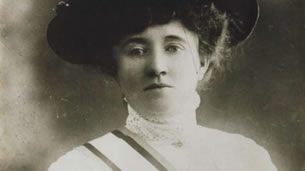Horse racing saw a major boom during the Victorian era when increasing prosperity, saw an increase in the number of racecourses being built. Hurst Park, beside the banks of the Thames in West Molesey was one such course. It opened in 1890.The first meeting to take place on Hurst Park, was on 19th March 1890 for a National Hunt meeting. In the 1960s the residential estate of Hurst Park was built on some of the racecourse land, but the area nearest the river was kept open for the public and landscaped, and so it is to this day.
On June 4 1913, Emily Wilding Davison, long term campaigner for women’s rights in England, stepped in front of the King’s horse and tried to attach a purple, green and white banner, emblazoned with ‘Votes for Women’ to the King’s Horse at the Epsom Derby. She died 4 days later from her injuries after the horses trampled her as they rounded the corner, and the horrifying tangle mess of human and animal was caught on the early news cameras and repeated across the country.
Kitty Marion had seen Emily only a few days before Epsom, they had discussed the fact that a protest ‘must be made’ but Kitty believed no specific action had been decided. What she did remember was Emily passing her a small green purse of money to use to buy ‘munitions’ and whatever she might else she might need to continue her destructive activities. On hearing of Emily’s death on the 8th of June, Kitty and another militant Suffragette, Clara Givens, travelled to west London and waited for night to fall.
In the early hours of the morning they dragged a large carpetbag filled with paraffin-soaked wood chips through the streets of Kew, and down towards Hurst Park racecourse. Reaching their destination at 2 a.m. they decided that the racecourse’s bandstand was the best target, and set about scattering ‘Votes of Women’ leaflets around the area so that everyone would know who had been responsible.
The fire started quicker than they had expected and the soon made they escape and began to head back to Kew. The police at this time, knew her as a violent and dangerous woman, and had probably been expecting her to commit an act of violence in response to Emily’s death. She was quickly arrested at her lodging’s within hours of returning there and was soon jailed for three years as her guilt was unquestionable. Kitty’s was quickly released under the Cat and Mouse Act and spent the next two years dodging the police as she committed many other acts of suffragette violence, occasionally returning to prison. She was, probably Edwardian England’s Most Dangerous Woman sent across the country to engage in, and instruct others in violence militant tactics.

